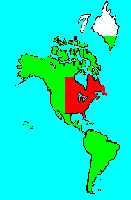SPECIES INFO
Rat Snake (Elaphe obsoleta) is found from New York to Texas and south through Florida. It can become quite long as examples over eight feet in length are known. Albino specimens are intentionally bred for the pet trade. There are several recognized subspecies as follows:
Black Rat (ssp obsoleta) NY, Oklahoma, Wis., Ga.
Yellow Rat (ssp quadrivittata) NC (Coastal Plain) to Fla.
Everglades Rat (ssp rossalleni) South Florida
Gray Rat (ssp spiloides) La and lower Miss. Val
Texas Rat (ssp lindheimeri) East Texas
Bairds Rat (ssp bairdi) Rio Grande vicinity of TexasElaphe genus contains about thirty species of snakes known as rat snakes and racers. There are members of this genus in North and South America and Eurasia. As taxonomists study this genus, the boundaries of this genus may change. For example, Elaphe subocularis of Texas and Mexico has been recently moved to Bogertophis subocularis; and, Elaphe rosaliae of Baja California has been moved to Bogertophis rosaliae.
Family Colubridae contains the vast majority (70% of all snakes) of the world's species of snakes. The number is estimated to be over 1,850 and possibly up to 2,500.
Lizards and Snakes (Squamata Order) share many common characteristics and consequently they are grouped in a single order. There are greater differences between some groups of lizards than there are between other groups of lizards and snakes. The same is true of snakes. Lizards and snakes share a common skull shape.
There are perhaps 4,000 species of lizards and perhaps 2,700 species of snakes alive today. In the Great Big Book of Snakes and Reptiles published in 2014, they noted the above estimates.
Reptiles (Class Reptilia) are an ancient group of scaled chordates. These scales may be permanently joined, as in the turtles, or flexible, as in the snakes. Reptiles are land-based. Their eggs are laid on land and the young are air breathing.
In the Great Big Book of Snakes and Reptiles published in 2014, they noted that there are more than 7,000 species of reptiles alive today.
Backboned Animals (Phylum Chordata) are the most advanced group of animals on earth. These animals are characterized by having a spinal cord or backbone. Most members have a clearly defined brain that controls the organism through a spinal cord. Fish, amphibians, reptiles, birds, and mammals are in this phylum.
Currently, some taxonomists believe that the fish should be divided into two groups (sharks and regular fishes) and that there are some other primitive groups in the phylum such as hagfish or lampreys.
Animal Kingdom contains numerous organisms that feed on other animals or plants. Included in the animal kingdom are the lower marine invertebrates such as sponges and corals, the jointed legged animals such as insects and spiders, and the backboned animals such as fish, amphibians, reptiles, birds, and mammals.






